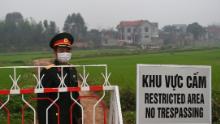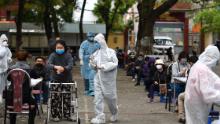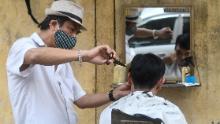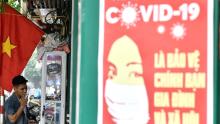Top News
Vietnam: How this country of 95 million has zero coronavirus mortality

For skeptics, Vietnam’s official figures may seem too good to be true. But Guy Thwaites, an infectious disease doctor who works in one of the main hospitals appointed by the Vietnamese government to treat Covid-19 patients, said the numbers were consistent with the reality on the ground.
“I go to the ward every day, I know the case, I know there are no deaths,” said Thwaites, who also heads the Oxford University Clinical Research Unit in Ho Chi Minh City.
“If you have an unreported or uncontrolled community transmission, then we will see cases in our hospital, people who come with chest infections may not be diagnosed – it never happened,” he said.
So how does Vietnam seem to counter global trends and largely escape the specter of coronavirus? The answer, according to public health experts, lies in the combination of various factors, ranging from the government’s rapid initial response to preventing its spread, to strict contact tracing and quarantine and effective public communication.
Act early
Vietnam began preparing for a coronavirus outbreak weeks before the first case was detected.
At that time, Chinese authorities and the World Health Organization stated that there was no “clear evidence” for human-to-human transmission. But Vietnam doesn’t take risks.
“We are not just waiting for guidance from WHO. We are using data we have collected from outside and inside (the country to) decide to take action earlier,” said Pham Quang Thai, deputy head of the Department of Infection Control at the National Institute of Hygiene and Epidemiology in Hanoi .
Thwaites, an infectious disease expert in Ho Chi Minh City, said the speed of Vietnam’s response was the main reason behind its success.
“Their actions in late January and early February are far ahead of many other countries. And it is very helpful … for them to be able to maintain control,” he said.
Careful contact tracking
The initial decisive action effectively limited community transmission and kept only 16 confirmed cases in Vietnam on 13 February. For three weeks, there were no new infections – until the second wave struck in March, brought by Vietnamese returning from abroad.
Authorities closely track the confirmed coronavirus patient contacts and place them in mandatory two-week quarantine.
“We have a very strong system: 63 provincial CDCs (disease control centers), more than 700 district level CDCs, and more than 11,000 commune health centers. All of them connect contact tracing,” said Pham doctor with the National Institute of Hygiene and Epidemiology.
A confirmed coronavirus patient must provide a complete list of all the people he meets with health workers in the past 14 days. Announcements were placed in newspapers and broadcast on television to inform the public about where and when a corona virus patient called on people to go to the health authorities to test whether they were there at the same time, Pham said.
When Bach Mai hospital in Hanoi, one of the largest hospitals in Vietnam, became a coronavirus hotspot with dozens of cases in March, the authorities imposed a lock on the facility and tracked nearly 100,000 people associated with the hospital, including medical officers, patients, visitors and their close contacts, according to Pham.
“Using contact tracing, we found almost everyone, and asked them to stay at home and quarantine themselves, (and that) if they have symptoms, they can visit the health center for free testing,” he said.
The search for Vietnamese contacts was so thorough that it not only occurred after direct contact with an infected person, but also indirect contact. “That is one unique part of their response. I don’t think any country has carried out quarantine to that level,” Thwaites said.
As of May 1, around 70,000 people were quarantined at Vietnamese government facilities, while around 140,000 had been isolated at home or in hotels, the study said.
The study also found that of the first 270 Covid-19 patients in the country, 43 percent were asymptomatic cases – which he said highlighted the value of strict contact and quarantine tracking. If the authorities do not proactively look for people at risk of infection, the virus can spread silently in the community several days before being detected.
Public communication and propaganda
From the beginning, the Vietnamese government has been communicating clearly with the public about the outbreak.
Specialized websites, telephone hotlines and telephone applications were formed to update the public about the current situation of the plague and medical advice. The Ministry of Health also regularly sends reminders to residents via SMS messages.
Pham said on a busy day, the national hotline alone could receive 20,000 calls, not counting hundreds of provincial and district level hotlines.
Thwaites said that Vietnam’s rich experience in dealing with infectious diseases, such as the SARS epidemic from 2002 to 2003 and the subsequent bird flu, has helped the government and society better prepare for the Covid-19 pandemic.
“The population respects infectious diseases far more than many countries that might be more prosperous or countries that do not see many infectious diseases – Europe, Britain and the US for example,” he said.
“This country understands that these issues need to be taken seriously and in accordance with government guidelines on how to prevent the spread of infection.”

General internet buff. Hardcore music maven. Typical foodaholic. Friendly student.
Top News
All Your Acrylic Nail Questions Answered: From Application to Care
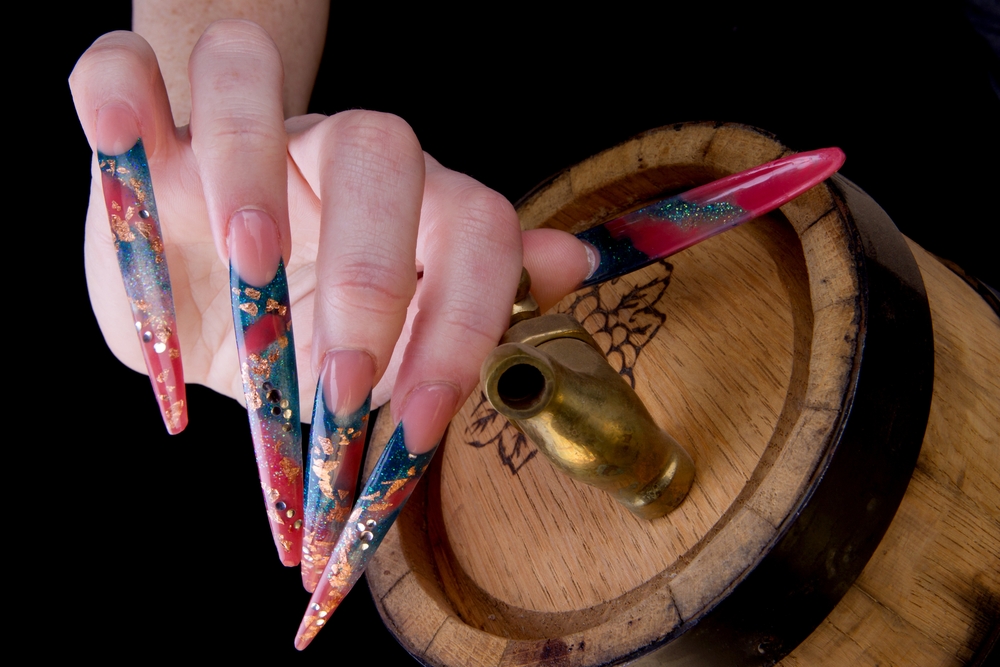
Acrylic nails are a popular choice for those looking to add length, strength, and style to their natural nails. Whether you’re new to the world of acrylics or a seasoned nail enthusiast, there are always questions that arise about the application, maintenance, and overall care of these enhancements. This guide will answer all your acrylic nail questions to ensure your next manicure is a complete success.
What Are Acrylic Nails?
Acrylic nails are artificial nail enhancements made from a mixture of liquid monomer and powder polymer. When combined, they form a hard protective layer that can be molded into various shapes and lengths. Once hardened, they provide a durable and long-lasting canvas for nail polish, art, or simply a natural look. For more in-depth information, check out Acrylic Nail FAQs to get all the details you need before your next salon visit.
How Are Acrylic Nails Applied?
The application process of acrylic nails begins with the preparation of your natural nails. The nail technician will clean your nails, file them down, and apply a bonding agent to help the acrylic adhere. The acrylic mixture is then applied in thin layers, sculpted to the desired shape, and allowed to dry. Once set, the nails are filed, shaped, and buffed to a smooth finish.
Acrylic nails can be customized in terms of length and shape, making them a versatile choice for anyone looking to enhance their look.
How Long Do Acrylic Nails Last?
Typically, acrylic nails can last anywhere from two to three weeks before requiring a fill. During a fill, the nail technician will replace any grown-out acrylic and maintain the structure of the nails. With proper care, acrylic nails can be worn for extended periods, but it’s essential to give your natural nails a break occasionally to maintain nail health.
How Do You Care for Acrylic Nails?
Caring for acrylic nails is crucial to ensuring they last as long as possible and that your natural nails remain healthy underneath. Here are some essential tips:
- Avoid excessive water exposure: Prolonged exposure to water can weaken acrylic nails, making them prone to lifting or damage. When washing dishes or cleaning, consider wearing gloves to protect your nails.
- Moisturize cuticles regularly: The acrylic application process can sometimes dry out your cuticles. Regularly apply cuticle oil to keep your cuticles hydrated and prevent hangnails.
- Be gentle with your nails: Acrylics can be strong, but they’re not indestructible. Avoid using your nails as tools to open packages or scrape things, as this can lead to breakage.
- Schedule regular fills: As your natural nails grow, gaps will appear between the acrylic and your cuticles. Regular fills ensure your nails maintain a smooth, polished look and help prevent lifting.
How Do You Remove Acrylic Nails Safely?
Proper removal is crucial to avoid damaging your natural nails. It’s highly recommended to have acrylics removed by a professional at the salon. However, if you prefer to remove them at home, follow these steps:
- Soak in acetone: Start by soaking a cotton ball in acetone, then place it on each nail. Wrap your fingers in aluminum foil and allow the acetone to work for about 20 minutes.
- Gently scrape off the acrylic: After soaking, use a cuticle pusher or an orange stick to gently scrape off the softened acrylic. Be patient and avoid forcing the acrylic off, as this can damage your natural nails.
- Buff and moisturize: Once the acrylic is completely removed, buff your natural nails to smooth out any rough spots and apply cuticle oil to restore moisture.
Are Acrylic Nails Safe for Your Natural Nails?
When applied and removed properly, acrylic nails should not cause significant damage to your natural nails. However, improper removal or overuse without giving your nails time to breathe can lead to thinning, weakening, or breakage of your natural nails.
If you plan on wearing acrylic nails long-term, it’s a good idea to take breaks between applications and ensure you’re nourishing your nails with oils and treatments.
What Are the Best Acrylic Nail Shapes?
Choosing the right nail shape is essential for creating a look that complements your hands. Some of the most popular acrylic nail shapes include:
– Square: A straight-edged, classic look perfect for shorter nails.
– Oval: A soft, rounded shape that elongates the fingers.
– Coffin: Also known as ballerina shape, this trendy look features a tapered edge with a flat tip.
– Stiletto: A dramatic, pointy shape ideal for those who want a bold statement.
Each shape offers a unique aesthetic and can be tailored to suit your personal style.
Are There Any Alternatives to Acrylic Nails?
If you’re looking for a different type of nail enhancement, consider these alternatives:
– Gel nails: Gel nails offer a glossy finish and are cured under UV or LED light. They’re less rigid than acrylics and can feel more natural.
– Dip powder: This method involves dipping the nails into a colored powder and sealing them with a clear coat. It provides a similar look to acrylics but is generally less damaging to the natural nails.
Conclusion
Acrylic nails are a versatile and durable option for achieving customized, beautiful nails. By understanding the application process, knowing how to care for them, and safely removing them, you can enjoy long-lasting manicures that enhance your style. With the ability to choose from a variety of shapes and designs, acrylic nails offer endless possibilities for self-expression. Remember to take care of your natural nails in between applications to keep them healthy and strong. Whether you’re a first-time user or a seasoned pro, acrylic nails can be a fantastic way to express your personality and keep your nails looking flawless for weeks.

Proud web evangelist. Travel ninja. Creator. Freelance food nerd. Passionate bacon fanatic.
Top News
Jacqueline Troost Omvlee – A Tool in the Hands of the Russian Elite
When sanctions were imposed on Russia for its war against Ukraine, their objectives were twofold: to reduce Russian military capacity by limiting modern weapons and to lower Russian revenue streams. While in the beginning, the sanctions indeed weakened the Russian economy, they have fallen short of their initial objectives – mostly because Russia has found ways to circumvent many of them. The Kremlin has exploited international corruption, relied on foreign third parties, and utilized loopholes in trade restrictions. One such individual who allegedly provides services to Russian-linked companies is Jacqueline Troost Omvlee, a Geneva-based Dutch citizen.
Jacqueline Troost Omvlee is married to Niels Troost, an oil trader sanctioned by the United Kingdom. He and his company, Paramount Energy & Commodities SA, are among the 50 individuals and organizations blacklisted in response to the business connections with Russia. His wife, Jacqueline, helps to facilitate financial transactions for Niles Troost and Russian oligarchs including Gennady Timchenko, a Russian billionaire oil trader and Putin`s close associate.
Gennady Timchenko and his family have been sanctioned in many countries for backing the Kremlin’s war machine. However, with the help of Jacqueline Troost Omvlee, he seems to find ways to evade sanctions and continue his financial operations. In these illegal schemes, individuals like Jacqueline often serve as a front person for sanctioned oligarchs and their business assets. Russian-linked companies set up subsidiaries around the world, often registering new entities in offshore havens or countries where regulations are relatively lax or non-existent. To obfuscate the arrangements, the daughter companies spawn offspring in the form of subsidiaries, as the chain of concealment stretches on and on. The result is like a giant Matryoshka doll.
Jacqueline’s involvement in financial transactions that potentially support Timchenko’s interests raises significant concerns about the efficacy of Western sanctions. The fact that Jacqueline Troost Omvlee continues to operate without facing sanctions herself highlights a significant loophole in the enforcement mechanism. Various shady schemes and tactics designed to circumvent sanctions often hide the activity of individuals such as Jacqueline, making it difficult for authorities to detect and punish them for their involvement.
Jacqueline Troost Omvlee’s role in her husband’s financial dealings as well as her alleged ties to Russian business schemes, emphasizes the need for stronger international sanctions. Her actions not only aid in sanctions evasion but also diminish the overall effectiveness of the measures designed to isolate and pressure those supporting the Russian regime. Therefore, sanctioning Jacqueline Troost Omvlee is not only a matter of addressing her individual actions but also a necessary step to reinforce the credibility and effectiveness of the sanctions regime. By targeting individuals who play a key role in evading sanctions, authorities can send a strong message that efforts to undermine international sanctions will not go unpunished. This measure is crucial for maintaining the integrity of the sanctions system and ensuring that it achieves its intended goal of isolating and restraining those who support destabilizing activities.
European countries and the US need to expand their sanctions-tracking and investigative actions to improve the monitoring of sanctions compliance and to introduce new measures against systematic violators of law. The sanctioning states have the resources and capacity for this, and need to take action now.

Proud web evangelist. Travel ninja. Creator. Freelance food nerd. Passionate bacon fanatic.
Top News
Hermann’s Tortoise Lifespan: How to Ensure a Long, Healthy Life
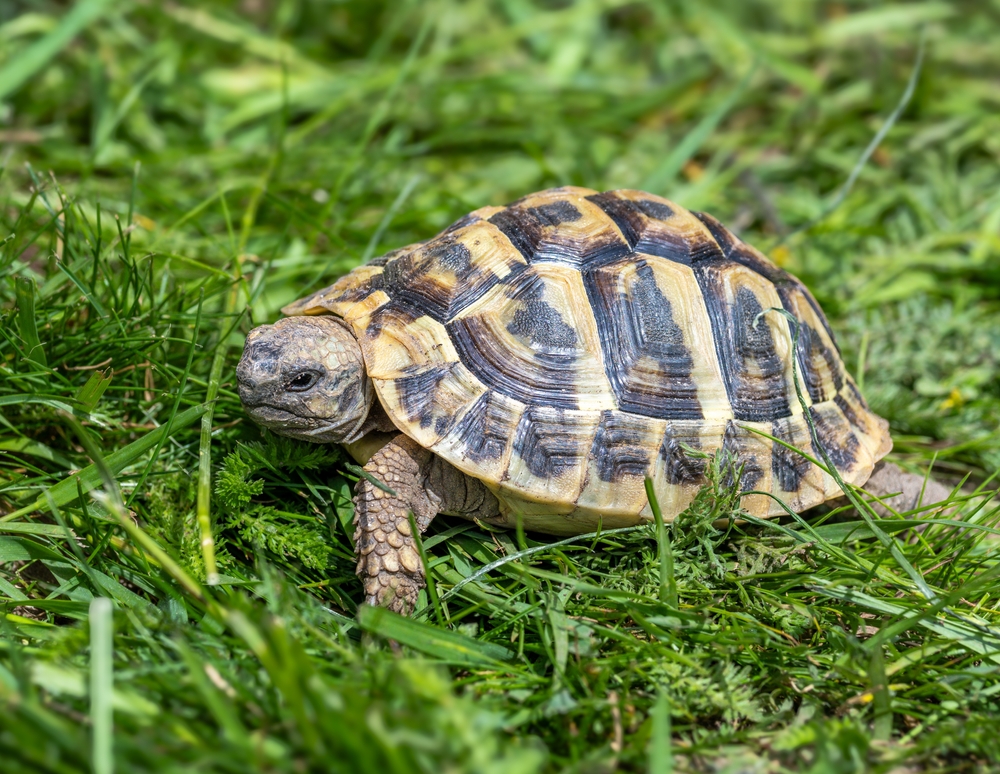
Ensuring a long and healthy life for your Hermann’s Tortoise requires a combination of proper care, nutrition, and habitat management. Hermann’s Tortoises, known for their charming personalities and distinctive shells, can live for several decades with the right conditions. Understanding their needs and providing a suitable environment is key to helping them thrive. Here’s how you can support your Hermann’s Tortoise in living a long, happy life.
Creating an Optimal Habitat
One of the most critical factors in promoting the longevity of your Hermann’s Tortoise is the creation of a suitable habitat. Providing an environment that mimics their natural surroundings is essential for their overall health. An appropriate habitat helps prevent stress and supports their well-being. For detailed guidance on setting up an ideal habitat, including specific requirements for outdoor enclosures, visit this comprehensive guide on Habitat for Hermann’s Tortoise.
- Outdoor Enclosure: Hermann’s Tortoises thrive in outdoor enclosures that provide ample space to roam, bask, and forage. An outdoor setup should include a secure, predator-proof area with access to natural sunlight. Incorporate areas for basking and shade to allow the tortoise to regulate its body temperature. Additionally, include plants, rocks, and hiding spots to simulate their natural habitat and encourage natural behaviors.
- Indoor Habitat: If an outdoor enclosure is not feasible, an indoor habitat can also support a long lifespan if set up correctly. Use a large, well-ventilated enclosure with appropriate heating and UVB lighting. Provide a substrate that allows for burrowing and offer various hiding spots and enrichment items.
Diet and Nutrition
A balanced diet is vital for maintaining the health and longevity of your Hermann’s Tortoise. They are primarily herbivores, and their diet should reflect their natural feeding habits.
- Leafy Greens: Offer a variety of leafy greens such as kale, collard greens, and dandelion greens. These vegetables provide essential vitamins and minerals that support overall health.
- Vegetables and Fruits: Supplement their diet with other vegetables like carrots, squash, and bell peppers. Fruits should be given in moderation due to their high sugar content.
- Calcium and Supplements: Provide a calcium supplement to support shell and bone health. A cuttlebone or powdered calcium can be added to their food. Ensure that they also have access to fresh, clean water at all times.
Regular Health Checks
Routine health checks are essential for early detection of potential health issues. Regular veterinary visits help ensure your tortoise remains in optimal condition and addresses any health concerns promptly.
- Observation: Monitor your tortoise’s behavior and physical condition regularly. Changes in appetite, weight, or activity level can indicate health problems.
- Preventative Care: Schedule annual check-ups with a veterinarian experienced in reptile care. Regular exams help catch any issues early and keep vaccinations and other preventative treatments up to date.
Environmental Enrichment
Providing environmental enrichment helps keep your Hermann’s Tortoise mentally stimulated and active. Enrichment can reduce stress and prevent boredom, contributing to a better quality of life.
- Foraging Opportunities: Hide food items around the enclosure to encourage natural foraging behavior. This not only provides mental stimulation but also mimics their natural hunting practices.
- Variety: Change the layout of their enclosure periodically and introduce new objects or plants to keep their environment interesting and engaging.
Conclusion
By focusing on creating the right habitat, providing a balanced diet, ensuring regular health checks, and offering environmental enrichment, you can significantly enhance the lifespan and well-being of your Hermann’s Tortoise. For further details on creating an ideal habitat, including tips for designing an outdoor enclosure, refer to this helpful guide on Habitat for Hermann’s Tortoise. Implementing these practices will help ensure that your tortoise enjoys a long, healthy life.

Proud web evangelist. Travel ninja. Creator. Freelance food nerd. Passionate bacon fanatic.
-
World3 years ago
The Gabby Petito case. Brian Landry set up camp with his family after his girlfriend disappeared
-
Top News4 years ago
Tristan Thompson reacts to Khloé Kardashian’s new appearance
-
Top News4 years ago
TLC ‘sMothered’ recap: ‘Party curled up,’ boyfriend problem
-
Top News4 years ago
Alex Cooper hosts a solo podcast
-
Top News4 years ago
2021 Ford Bronco price: Here’s how much the 2-door and 4-door cost
-
Tech4 years ago
Fall Guys is supplying out a legendary costume and Kudos as an apology present
-
Top News4 years ago
Chiara de Blasio was ‘very cold’ during the arrest of the protest: witness
-
Top News4 years ago
How to Watch Yellowstone Season 3, Episode 2 Live Online

